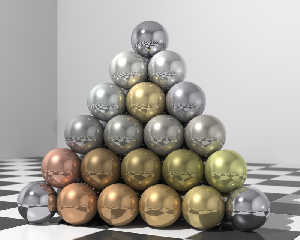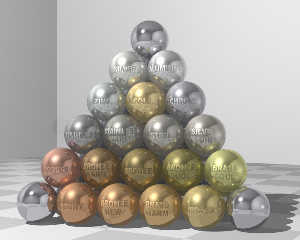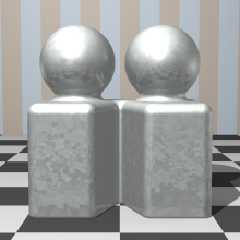 |
 |
|
 |
|
 |
|  |
|  |
|
 |
|
 |
|  |
|  |
|
 |
I have found it surprisingly difficult to get color or reflectivity data for
the various metals. There are plenty of descriptions of the quantum physics
behind metallic colors, but almost no graphs or tables of the spectral
reflectivity curves that result. The little data i can find often conflict
with each other. The Web is jam packed with dry, long winded,
subscription-only science papers on how tempering such and such metal
affects infrared reflectivity--all well and good if you're into that sort
of thing, but i'm not exactly trying to design a space helmet visor. I'd
just like some convincing-looking ray-traced shiny things.
The files colors.inc, metals.inc, and golds.inc don't say where their values
came from. I suspect that they're just guesses. Some of the values in
colors.inc look really suspect, such as Copper, CoolCopper, BrightGold, and
Silver. If anyone from the POV team has more information, it would be
welcome.
I appreciate that the optical properties of metals vary--espcially with the
copper alloys. But for almost no one to have published at least a range, a
baseline, or an average to start with?
For this image, in order to avoid aliasing artifacts with the spaces between
the obligatory checkered tiles, i rendered the image at double size and then
downsampled it using the GIMP. This was partially successful. Of course, i
could have avoided the problem by widening the cracks, but then it would
become obvious that they're just surface normals, not real cracks. :-p
Post a reply to this message
Attachments:
Download 'stacked.jpg' (87 KB)
Preview of image 'stacked.jpg'

|
 |
|  |
|  |
|
 |
|
 |
|  |
|  |
|
 |
These are the values that i used for the metal colors. They were gleaned
from a fusion of Web data, household articles, hardware from The Home
Depot, illustrations from metallia.com, and loose change.
#declare c_ALUMINUM = rgb <0.89, 0.91, 0.91>;
#declare c_BRASS_COOL = rgb <0.80, 0.80, 0.35>;
#declare c_BRASS = rgb <0.80, 0.65, 0.30>;
#declare c_BRASS_WARM = rgb <0.80, 0.55, 0.25>;
#declare c_BRONZE_NEW = rgb <0.80, 0.50, 0.25>; //polished, no patina
#declare c_BRONZE_WARM = rgb <0.45, 0.30, 0.15>;
#declare c_BRONZE = rgb <0.45, 0.35, 0.15>;
#declare c_BRONZE_COOL = rgb <0.45, 0.40, 0.15>;
#declare c_CHROME = rgb <0.61, 0.61, 0.65>; //duplex Ni + Cr
#declare c_COPPER = rgb <0.80, 0.45, 0.35>;
#declare c_GOLD = rgb <0.95, 0.775, 0.40>;
#declare c_PENNY = rgb <0.80, 0.45, 0.25>; //"penny bronze" 5% Zn
#declare c_SILVER = rgb <0.96, 0.96, 0.92>;
#declare c_SILVER_COIN = rgb <0.66, 0.63, 0.57>; //75% Cu + 25% Ni
#declare c_STAINLESS = rgb 0.49;
#declare c_STAINLESS_WARM = rgb <0.51, 0.51, 0.47>;
#declare c_STEEL = rgb <0.61, 0.59, 0.54>;
#declare c_ZINC = rgb <0.78, 0.82, 0.80>;
Notes:
- It appears that bronze can be *almost* *any* color--black, brown, olive,
gold, green, gray, etc. My values were pure guesswork. I can find lots
of "bronze" items in novelty stores and in The Home Depot, but who knows
how much of it was painted on?
- c_CHROME is for electroplated chromium over nickel. It is not the color
of solid chromium, which is a rare beast.
- Freshly minted (American) pennies appear to be the same color as copper
pipe, but they quickly turn an orange color before the shine even wears
off.
- c_ZINC makes a good galvanized texture when used with normal { facets }
and a low reflection { }.
Post a reply to this message
Attachments:
Download 'stackedn.jpg' (52 KB)
Preview of image 'stackedn.jpg'

|
 |
|  |
|  |
|
 |
|
 |
|  |
|  |
|
 |
All that work creating the metal textures, and what I want to know is...
How did you do the text on the spheres? :-)
--
William Tracy
+-+-+-+-+-+-+-+-+-+-+-+-+-+-+-+-+-+-+-+-+-+
|a|f|i|s|h|i|o|n|a|d|o|@|g|m|a|i|l|.|c|o|m|
+-+-+-+-+-+-+-+-+-+-+-+-+-+-+-+-+-+-+-+-+-+
+-+-+-+-+-+-+-+-+-+-+-+-+-+-+-+-+-+-+
|w|t|r|a|c|y|@|c|a|l|p|o|l|y|.|e|d|u|
+-+-+-+-+-+-+-+-+-+-+-+-+-+-+-+-+-+-+
You know you've been raytracing too long when you spend 4 days at work
wondering how to render your tongue.
David Kraics
Post a reply to this message
|
 |
|  |
|  |
|
 |
|
 |
|  |
|  |
|
 |
Neat...
Post a reply to this message
|
 |
|  |
|  |
|
 |
|
 |
|  |
|  |
|
 |
William Tracy <wtr### [at] calpoly edu> wrote:
> All that work creating the metal textures, and what I want to know is...
>
> How did you do the text on the spheres? :-)
I uv-mapped a texture of a text object pattern, where the positive space has
a reflection { } value of 0.
#local Stamp = text { ... }
#local T1 = Metal (Palette [Index + Unit], Spec);
#local T2 = Metal (Palette [Index + Unit], 0);
#local N1 = normal { object { Stamp } -0.05 accuracy 0.002 };
texture
{ uv_mapping object
{ Stamp
texture { T1 normal { N1 } }
texture { T2 normal { N1 } }
}
}
Some context: Metal() is a macro that i wrote that returns a metallic
texture. Palette (Index + Unit) is an rgb value, and Spec is a reflection
{ } value. edu> wrote:
> All that work creating the metal textures, and what I want to know is...
>
> How did you do the text on the spheres? :-)
I uv-mapped a texture of a text object pattern, where the positive space has
a reflection { } value of 0.
#local Stamp = text { ... }
#local T1 = Metal (Palette [Index + Unit], Spec);
#local T2 = Metal (Palette [Index + Unit], 0);
#local N1 = normal { object { Stamp } -0.05 accuracy 0.002 };
texture
{ uv_mapping object
{ Stamp
texture { T1 normal { N1 } }
texture { T2 normal { N1 } }
}
}
Some context: Metal() is a macro that i wrote that returns a metallic
texture. Palette (Index + Unit) is an rgb value, and Spec is a reflection
{ } value.
Post a reply to this message
|
 |
|  |
|  |
|
 |
|
 |
|  |
|  |
|
 |
"Cousin Ricky" <ric### [at] yahoo com> wrote:
> I have found it surprisingly difficult to get color or reflectivity data for
> the various metals. There are plenty of descriptions of the quantum physics
> behind metallic colors, but almost no graphs or tables of the spectral
> reflectivity curves that result. The little data i can find often conflict
Different metals have distinct colours and alloying alters these colours,
but reflectivity is dependent on surface finish, not composition. A
near-perfect mirror could be made of steel, aluminium, titanium or
anything; if it's polished sufficiently finely it's impossible to tell the
difference just by eye. There is no such thing as a 'characteristic'
reflectivity. Colour is the parameter to search for.
The best thing to do is to play with the texture until it looks right! :-)
Bill com> wrote:
> I have found it surprisingly difficult to get color or reflectivity data for
> the various metals. There are plenty of descriptions of the quantum physics
> behind metallic colors, but almost no graphs or tables of the spectral
> reflectivity curves that result. The little data i can find often conflict
Different metals have distinct colours and alloying alters these colours,
but reflectivity is dependent on surface finish, not composition. A
near-perfect mirror could be made of steel, aluminium, titanium or
anything; if it's polished sufficiently finely it's impossible to tell the
difference just by eye. There is no such thing as a 'characteristic'
reflectivity. Colour is the parameter to search for.
The best thing to do is to play with the texture until it looks right! :-)
Bill
Post a reply to this message
|
 |
|  |
|  |
|
 |
|
 |
|  |
|  |
|
 |
Cousin Ricky wrote:
> These are the values that i used for the metal colors.
There's just something about the labels that has me giggling.
--
Darren New / San Diego, CA, USA (PST)
I bet exercise equipment would be a lot more
expensive if we had evolved from starfish.
Post a reply to this message
|
 |
|  |
|  |
|
 |
|
 |
|  |
|  |
|
 |
Bill Pragnell wrote:
> "Cousin Ricky" <ric### [at] yahoo com> wrote:
>
>>I have found it surprisingly difficult to get color or reflectivity data for
>>the various metals. There are plenty of descriptions of the quantum physics
>>behind metallic colors
>
> difference just by eye. There is no such thing as a 'characteristic'
> reflectivity. Colour is the parameter to search for.
and RGB values for the colors are also not good enough if you
aim for physical accuracy, because they are actually the result
of both light source and material characteristics. Check out
http://www.ignorancia.org/en/index.php?page=Lightsys com> wrote:
>
>>I have found it surprisingly difficult to get color or reflectivity data for
>>the various metals. There are plenty of descriptions of the quantum physics
>>behind metallic colors
>
> difference just by eye. There is no such thing as a 'characteristic'
> reflectivity. Colour is the parameter to search for.
and RGB values for the colors are also not good enough if you
aim for physical accuracy, because they are actually the result
of both light source and material characteristics. Check out
http://www.ignorancia.org/en/index.php?page=Lightsys
Post a reply to this message
|
 |
|  |
|  |
|
 |
|
 |
|  |
|  |
|
 |
Cousin Ricky nous apporta ses lumieres en ce 2007/07/07 15:01:
> These are the values that i used for the metal colors. They were gleaned
> from a fusion of Web data, household articles, hardware from The Home
> Depot, illustrations from metallia.com, and loose change.
>
> #declare c_ALUMINUM = rgb <0.89, 0.91, 0.91>;
> #declare c_BRASS_COOL = rgb <0.80, 0.80, 0.35>;
> #declare c_BRASS = rgb <0.80, 0.65, 0.30>;
> #declare c_BRASS_WARM = rgb <0.80, 0.55, 0.25>;
> #declare c_BRONZE_NEW = rgb <0.80, 0.50, 0.25>; //polished, no patina
> #declare c_BRONZE_WARM = rgb <0.45, 0.30, 0.15>;
> #declare c_BRONZE = rgb <0.45, 0.35, 0.15>;
> #declare c_BRONZE_COOL = rgb <0.45, 0.40, 0.15>;
> #declare c_CHROME = rgb <0.61, 0.61, 0.65>; //duplex Ni + Cr
> #declare c_COPPER = rgb <0.80, 0.45, 0.35>;
> #declare c_GOLD = rgb <0.95, 0.775, 0.40>;
> #declare c_PENNY = rgb <0.80, 0.45, 0.25>; //"penny bronze" 5% Zn
> #declare c_SILVER = rgb <0.96, 0.96, 0.92>;
> #declare c_SILVER_COIN = rgb <0.66, 0.63, 0.57>; //75% Cu + 25% Ni
> #declare c_STAINLESS = rgb 0.49;
> #declare c_STAINLESS_WARM = rgb <0.51, 0.51, 0.47>;
> #declare c_STEEL = rgb <0.61, 0.59, 0.54>;
> #declare c_ZINC = rgb <0.78, 0.82, 0.80>;
>
> Notes:
>
> - It appears that bronze can be *almost* *any* color--black, brown, olive,
> gold, green, gray, etc. My values were pure guesswork. I can find lots
> of "bronze" items in novelty stores and in The Home Depot, but who knows
> how much of it was painted on?
>
> - c_CHROME is for electroplated chromium over nickel. It is not the color
> of solid chromium, which is a rare beast.
>
> - Freshly minted (American) pennies appear to be the same color as copper
> pipe, but they quickly turn an orange color before the shine even wears
> off.
>
> - c_ZINC makes a good galvanized texture when used with normal { facets }
> and a low reflection { }.
>
>
>
> ------------------------------------------------------------------------
>
I've seen photos of pure, solid chrome. It's slightly yellowish, tending toward
a shiny straw like colour. When plated on some other metal, it tends to loose
that tint, unless the plating is *very* thick.
I have manipulated a lot of zinc, it's prety soft and usualy hard to polish.
I've never seen zinc as shiny as your's. It asks for diffuse reflection.
Metals do have an ior, ranging from around 5 up to over 30 and possibly more.
Just don't ask me HOW metalurgy scientists managed to calculate it... It depend
on the exact aloy. Set it and use fresnel in the reflection block, it can
improve the realism, together with variable reflection.
The metals textures in metals.inc have insanely high ambient values (from 0.1 to
0.35!). Everybody should replace all the ambient values found by "ambient 0", or
just remove the ambient entries. Personaly, I find that it give beter results.
--
Alain
-------------------------------------------------
Seventh Day Adventism: No shit shall happen on Saturday.
Post a reply to this message
|
 |
|  |
|  |
|
 |
|
 |
|  |
|  |
|
 |
Alain <ele### [at] netscape net> wrote:
> I have manipulated a lot of zinc, it's prety soft and usualy hard to polish.
> I've never seen zinc as shiny as your's. It asks for diffuse reflection.
I just used a blanket reflection value of 0.5 on all of them. (Note that my
chrome isn't shiny enough!) True, zinc does best with a reflection { 0.1 }
or so. I've attached a galvanized "thing." Unfortunately, i don't
remember the exact texture i used.
A zinc coin: http://www.elementsales.com/ebay/gen/ecoins/ec-zn-1_obvrev.jpg
Solid chromium: http://www.elementsales.com/photo/large/rd-cr-23_wf.jpg
> Metals do have an ior, ranging from around 5 up to over 30 and possibly more.
> Just don't ask me HOW metalurgy scientists managed to calculate it... It depend
> on the exact aloy. Set it and use fresnel in the reflection block, it can
> improve the realism, together with variable reflection.
According to the documentation, reflection { metallic } automatically
calculates the Fresnel effect. Incidentally, i have tried IORs up to
around 200 with Fresnel on non-metallic transparent spheres, and they do
take on an opaque metallic appearance.
> The metals textures in metals.inc have insanely high ambient values (from 0.1 to
> 0.35!).
So i noticed.
> Everybody should replace all the ambient values found by "ambient 0", or
> just remove the ambient entries. Personaly, I find that it give beter results.
I scale down ambient and diffuse as i increase the reflection { } value. net> wrote:
> I have manipulated a lot of zinc, it's prety soft and usualy hard to polish.
> I've never seen zinc as shiny as your's. It asks for diffuse reflection.
I just used a blanket reflection value of 0.5 on all of them. (Note that my
chrome isn't shiny enough!) True, zinc does best with a reflection { 0.1 }
or so. I've attached a galvanized "thing." Unfortunately, i don't
remember the exact texture i used.
A zinc coin: http://www.elementsales.com/ebay/gen/ecoins/ec-zn-1_obvrev.jpg
Solid chromium: http://www.elementsales.com/photo/large/rd-cr-23_wf.jpg
> Metals do have an ior, ranging from around 5 up to over 30 and possibly more.
> Just don't ask me HOW metalurgy scientists managed to calculate it... It depend
> on the exact aloy. Set it and use fresnel in the reflection block, it can
> improve the realism, together with variable reflection.
According to the documentation, reflection { metallic } automatically
calculates the Fresnel effect. Incidentally, i have tried IORs up to
around 200 with Fresnel on non-metallic transparent spheres, and they do
take on an opaque metallic appearance.
> The metals textures in metals.inc have insanely high ambient values (from 0.1 to
> 0.35!).
So i noticed.
> Everybody should replace all the ambient values found by "ambient 0", or
> just remove the ambient entries. Personaly, I find that it give beter results.
I scale down ambient and diffuse as i increase the reflection { } value.
Post a reply to this message
Attachments:
Download 'galvanized.png' (40 KB)
Preview of image 'galvanized.png'

|
 |
|  |
|  |
|
 |
|
 |
|  |
|
 |




![]()